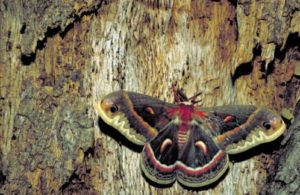In looking at moth conservation research over the last week, it quickly became clear that we have something of a love-hate relationship with these insects, a relationship that is heavily influenced by whether or not a species is native. As might be expected, native species are often in trouble and non-natives often cause trouble for us. And sometimes it’s our reaction to the invasive species that has caused problems for native moths.
When we look at the invasive side of the coin, we only have to look at the gypsy moth, the browntail moth, and the cactus moth to find species that have radically changed the environments they are in, and sometimes that change was our goal. Cactus moths are native to South America but were introduced in a number of locations, including Australia, as a biological control for invasive cacti species (Zimmermann et al. 2001). That biological control worked pretty well, but now the species has arrived in North America and could threaten our native cacti such as prickly pears. We also have a history of using biological controls against invasive moths, and the results aren’t always what we intended. We released a moth parasite, the fly Compsilura concinnata, to control gypsy moth populations in the US starting in 1906 (Elkinton et al. 2006). While the fly does prey on gypsy and browntail moths, it also has attacked at least 180 native species, and research published in 2000 suggested that at least two species of native silk moth have been severely impacted by the fly (Boettner et al. 2000).
Unfortunately the challenges facing native moths go beyond unexpected impacts of biological control. By 2006 the UK had seen sharp declines in more than half of 337 common moth species surveyed (Conrad et al. 2006)- since the researchers did not have enough data to complete the same analyses for rare moth species, their results probably underestimated the actual declines in British moths. Nieminen (1996) suggested that moths differ in their risk of extinction based, in part, on what they eat- moths that eat perennials are less at risk than moths that eat annuals. Why are perennials less risky? These food sources are more stable year to year, whereas annuals may be present one summer and then gone the next. When you add the effects of habitat conversion and fragmentation, a population of annual-eating moths may lose all local food sources in a short amount of time. Of course, perennials may take longer to establish and grow large enough to support moths, and so perennial-eating moths could be at risk if habitat disturbance is big enough.
Why should we care about declining moth populations? It turns out that there are many more moths than butterflies (Ricketts et al. 2002), and these insects are important as pollinators, herbivores, and food for other animals (Summerville and Crist 2004). Because they are nocturnal and inhabit forests as well as meadows (Ricketts et al. 2002), hummingbirds and butterflies can’t just step into their shoes as pollinators or as food for migrating passerine birds- if we lose the moths, we lose important ecological relationships.
Fortunately, we are constantly developing a better understanding of what moths need to survive- in my next post I’ll look what we know about supporting moth populations.
Works cited:
Boettner, G.H., J.S. Elkinton, and C.J. Boettner. 2000. Effects of a Biological Control Introduction on Three Nontarget Native Species of Saturniid Moths. Conservation Biology 14:1798–1806.
Conrad, K.F., M.S. Warren, R. Fox, M.S. Parsons, and I.P. Woiwod. 2006. Rapid declines of common, widespread British moths provide evidence of an insect biodiversity crisis. Biological Conservation 132:279–291.
Elkinton, J.S., D. Parry, and G.H. Boettner. 2006. Implicating an Introduced Generalist Parasitoid in the Invasive Browntail Moth’s Enigmatic Demise. Ecology 87:2664–2672.
Nieminen, M. 1996. Risk of Population Extinction in Moths: Effect of Host Plant Characteristics. Oikos 76:475–484.
Ricketts, T.H., G.C. Daily, and P.R. Ehrlich. 2002. Does butterfly diversity predict moth diversity? Testing a popular indicator taxon at local scales. Biological Conservation 103:361–370.
Summerville, K.S., and T.O. Crist. 2004. Contrasting Effects of Habitat Quantity and Quality on Moth Communities in Fragmented Landscapes. Ecography 27:3–12.
Zimmermann, H.G., V.C. Moran, and J.H. Hoffmann. 2001. The renowned cactus moth, Cactoblastic cactorum (Lepidoptera: Pyralidae): its natural history and threat to native opuntia floras in Mexico and the United State of America. The Florida Entomologist 84:543–551.

